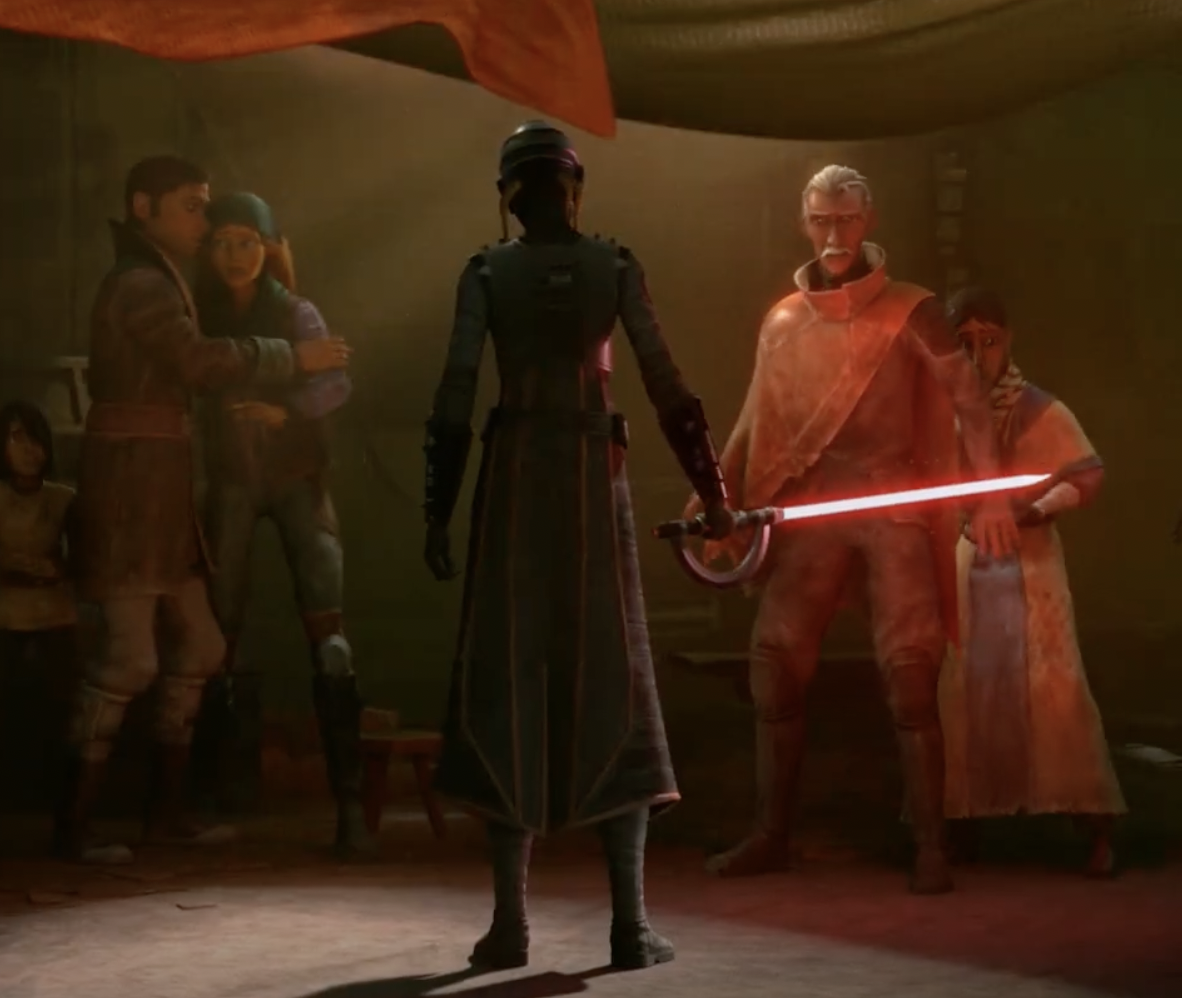

In Season 1, Episode 5 of the Disney Plus series Tales of the Empire, titled “Realization,” the narrative unfolds on an unknown wasteland world where Barriss (Meredith Salenger) and the Fourth Sister (Rya Kihlstedt) are sent to hunt down a Jedi (Ry Chase). The two Inquisitors confront the villagers to ascertain the Jedi’s whereabouts. The villagers, led by their governor (Keith Ferguson), harbor a disdain for the Empire and adhere to their code, asserting that people are judged by their actions, not their words. While the Empire claims to seek peace and order, the villagers perceive their true intentions as rooted in spreading hate and destruction to maintain power. In essence, the governor and the villagers harbor antipathy towards the Inquisitors and deceitfully deny knowledge of any Jedi. However, a frightened young girl (Jordyn Curet) divulges to Barriss that the Jedi is located in the mountains. Enraged by the deception, the Fourth Sister ruthlessly slaughters the villagers, sparing only the young girl as a witness to the consequences of defying the Empire.
Atop the mountain, the Fourth Sister and Barriss engage in a duel with the Jedi. The Jedi emerges victorious over the Fourth Sister, rendering her unconscious. Barriss finds herself alone in combat with the Jedi and endeavors to persuade them to join the Empire. Despite the Jedi’s refusal and display of unwavering conviction, tinged with fear and weariness from prolonged evasion, Barriss is moved by their vulnerability. Her shock intensifies when the Fourth Sister mercilessly strikes down the Jedi, abandoning them to perish. Horrified by the Empire’s cruelty and malevolence, Barriss defects, redeeming herself as a Jedi by aiding the injured Jedi and utilizing the Force to propel the Fourth Sister off the mountain. The episode concludes with Barriss, recalling her training as a Jedi healer, tending to the Jedi’s wounds.


The Fourth Sister Commits Murder
Season 1, Episode 5 of Tales of the Empire, titled “Realization,” directed by Steward Lee penned by Matt Michnovetz, Barriss’ journey undergoes a profound transformation, marked by themes of redemption, disillusionment, and the inherent struggle between darkness and light.
Barriss and the Fourth Sister’s pursuit of a Jedi on this forsaken world represents the pursuit of truth and identity. The Jedi, embodying the remnants of hope and resistance against the Empire, becomes a symbol of Barriss’ own internal conflict and the choice she must make between loyalty to the Empire and rediscovering her Jedi principles.
The confrontation with the villagers, led by their governor, serves as a microcosm of the larger conflict between the Empire and those who resist its tyranny. The villagers’ refusal to cooperate with the Inquisitors reflects their defiance against oppression and their commitment to principles of justice and integrity, contrasting sharply with the Empire’s authoritarian rule.
The duel atop the mountain between Barriss, the Fourth Sister, and the Jedi becomes a battleground not only of physical prowess but also of ideological struggle. Barriss’ attempt to persuade the Jedi to join the Empire represents her own internal struggle to reconcile her past actions with her inherent sense of morality.
The Jedi’s refusal to submit to the Empire, despite their vulnerability and weariness, serves as a reminder of the resilience of the human spirit in the face of adversity. Their steadfast conviction inspires Barriss and prompts her to confront the darkness within herself.
The Fourth Sister’s betrayal of the Jedi and Barriss’ subsequent act of redemption symbolize the eternal battle between good and evil within the individual. Barriss’ decision to defy the Empire and save the injured Jedi represents her rejection of darkness and reaffirmation of her Jedi principles.
The episode concludes with Barriss tending to the Jedi’s wounds, symbolizing her acceptance of her role as a healer and guardian of peace. Through her actions, Barriss embarks on a journey of redemption, reclaiming her identity as a Jedi and embracing the light once more.
However, the episode presented significant problems in portraying Barriss’ redemption. During The Clone Wars series, Barriss committed murder by callously using an innocent man as a time bomb, resulting in the deaths of numerous Jedi, citizens, and soldiers at the Jedi Temple. Furthermore, she attempted to frame Ahsoka for her crimes and made an effort to kill Ahsoka while the latter was on the run. In essence, Barriss’ redemption appears rushed and lacks sufficient development, considering her previous fall to the Dark Side during the events of The Clone Wars. In the Star Wars universe, redemption is depicted as a process requiring immense willpower and time to rediscover the path to the light. Anakin’s redemption, for example, held significant meaning because few believed he could be redeemed, yet Luke succeeded where others, such as Obi-Wan and Ahsoka, had failed.
Rating: 7/10
